如何通过vba检查单元格是否为空?
要检查单元格是否为空,可以使用VBA 的 ISEMPTY 函数。在此函数中,您需要使用 range 对象来指定要检查的单元格,如果该单元格为空则返回 true,否则返回 false。您可以使用消息框或使用单元格来获取结果。
使用VBA检查单元格是否为空
- 从函数名称“IsEmpty”开始。
- 指定要检查的单元格。
- 使用消息框或单元格来获取结果值。
- 最后,运行代码。
MsgBox IsEmpty(Range("A1"))
检查多个单元格是否为空
如果您想在需要迭代区域中的每个单元格时检查并计算区域中的空单元格。
Sub vba_check_empty_cells() Dim i As Long Dim c As Long Dim myRange As Range Dim myCell As Range Set myRange = Range("A1:A10") For Each myCell In myRange c = c + 1 If IsEmpty(myCell) Then i = i + 1 End If Next myCell MsgBox _ "There are total " & i & " empty cell(s) out of " & c & "." End Sub上面的代码遍历 A1:A10 范围内的每个单元格,并使用 ISEMPTY 函数一一检查每个单元格是否为空。
对于每个空单元格,它都会进行计数,最后显示一个消息框,其中包含单元格和空单元格的总数。
如果您还想突出显示空单元格,请使用以下代码。
Dim i As Long Dim c As Long Dim myRange As Range Dim myCell As Range Set myRange = Range("A1:A10") For Each myCell In myRange ' c = c + 1 If IsEmpty(myCell) Then myCell.Interior.Color = RGB(255, 87, 87) i = i + 1 End If Next myCell MsgBox _ "There are total " & i & " empty cell(s) out of " & c & "." 什么是VBA
相关教程
- 在 Excel 中使用 VBA 计算行数
- Excel VBA 字体(颜色、大小、类型和粗体)
- Excel VBA 隐藏和显示列或行
- Excel VBA 范围 – 使用范围和单元格
- 在 Excel 中使用 VBA 将边框应用于单元格